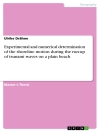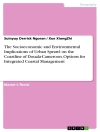‘Nature’s Fury: Navigating Natural Hazards in Mountainous Topographies’ shall be a comprehensive guide to the unique challenges and hazards associated with mountainous regions, and the efforts being made to mitigate their impact. The book shall provide a detailed overview of natural hazards such as earthquakes, landslides, avalanches, and flash floods, and explores their impacts on communities and the environment. It would delve into the science of risk assessment and vulnerability analysis, and shall offer practical insights into mitigation strategies such as early warning systems, evacuation plans, and disaster response efforts. The book will also explore the role of technology and predictive modeling in mountain hazards management, and the relationship between mountain hazards and climate change.
With realworld examples and case studies from the Himalayas, the Andes, and the Rockies, the book shall provide a comprehensive examination of the field of mountain hazards management. It will cover community-based disaster management and preparedness, environmental conservation and sustainable development, and the balancing of tourism and conservation in mountainous regions. The book will also include lessons learned from major mountain disasters, and the importance of international cooperation in mountain hazards management.
It would cater wide audience including professionals in the field of disaster management, an environmental scientist, or even an enthusiast of mountain landscapes. We propose to have an engaging writing style and practical insights in this book, that will provide a valuable resource for anyone interested in navigating the unique challenges and hazards of mountainous topographies.
İçerik tablosu
Foundations and Frontiers: An Overview of Natural Hazard Management in Mountainous Regions.- Part I.Understanding the Hazards: Geospatial and Geological Insights.- Groundwater and its impact on landslides along Himalayan Regions-A Review
Geospatial Modelling of Seismic Vulnerability using Entropy-AHP-A Case Study of the Himalayas.- Modeling Landslides Using Analytical Hierarchy Process (AHP) and Geospatial Techniques to Mitigate Hazard Risks in the High Mountain Himalayan Landscapes of Sikkim and Darjeeling, India.- Housing Lessons Post-2022 Afghanistan Earthquake.- The Damage and Reconstruction Challenges in Mountainous Areas in the July 2020 heavy rain disaster in Japan.- Cases of damage caused by mountain hazards that occurred in Japan from 2014 to 2022.- Landslides information by geological environment in mountain hazards in Japan.- Part II.Approaches to Mitigation and Management: Leveraging Technology and Knowledge.- Wide-area extraction method for sediment runoff range after mountain disasters in Japan.- Harnessing Local and Indigenous Knowledge for Effective Geo-Hazard Mitigation and Management in Oke Imesi Ekiti, Nigeria.- A Comprehensive Guide to Stopping another Flood Calamity using geology and GIS applications-Case Study from Pakistan.- Application of Relative Effect Method for assessment of Landslide Susceptibility Mapping along Mughal road, NW Himalayan region, Jammu and Kashmir, India.- Community and Artificial Intelligence-Enabled Disaster Management and Preparedness Remote Sensing of ‘Ghost Villages’-The Challenge of Rural Migration in the Mountainous state of Uttarakhand, India.- Adventure in High Altitude of Mountainous Topographies and Health Impacts: Lensing Tourism Sustainability via Reducing Ecological and Sociocultural Footprint and Health Emergency and Medical Assistance Management.- Resilience and Recovery – Utilizing the Japan Assessment of Disaster Risks and Ecosystem Services (J-ADRES) Tool to Address Land Use and Infrastructure Challenges in Japan.












